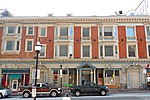The Metropolitan Archdiocese of Baltimore (Latin: Archidiœcesis Baltimorensis) is the premier (or first) see of the Latin Church of the Catholic Church in the United States. The archdiocese comprises the City of Baltimore and nine of Maryland's 23 counties in the central and western portions of the state: Allegany – Anne Arundel – Baltimore – Carroll, Frederick, Garrett–Harford, Howard, and Washington. The archdiocese is the metropolitan see of the larger regional Ecclesiastical Province of Baltimore. The Archdiocese of Washington was originally part of the Archdiocese of Baltimore.
The Archdiocese of Baltimore is the oldest diocese in the United States whose see city was entirely within the nation's boundaries when the United States declared its independence in 1776. The Holy See granted the archbishop of Baltimore the right of precedence in the nation at liturgies, meetings, and Plenary Councils on August 15, 1859. Although the Archdiocese of Baltimore does not enjoy "primatial" status, it is the premier episcopal see of the Roman Catholic Church in the United States of America, as "prerogative of place".
Within the archdiocese are 518,000 Catholics, 145 parishes, 545 priests (244 diocesan priests, 196 priests resident in diocese), 159 permanent deacons, 55 brothers, 803 sisters, five hospitals, 28 aged homes, 7 diocesan/parish high schools, 13 private high schools, and four Catholic colleges/universities.
The Archdiocese of Baltimore has two major seminaries: St. Mary's Seminary and University in Baltimore and Mount St. Mary's Seminary in Emmitsburg.This archdiocese was featured in the Netflix documentary The Keepers exposing the sexual abuse history at Archbishop Keough High School and the murder of Sister Catherine Cesnik in 1969. It was revealed in late 2016 that the Archdiocese of Baltimore had paid off numerous settlements since 2011 for abuse victims.









